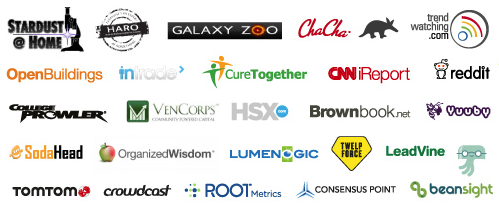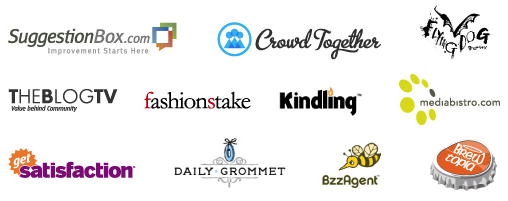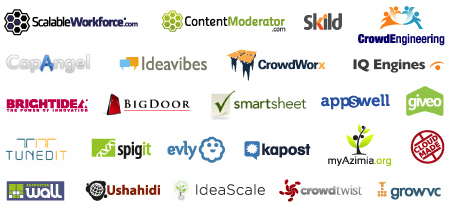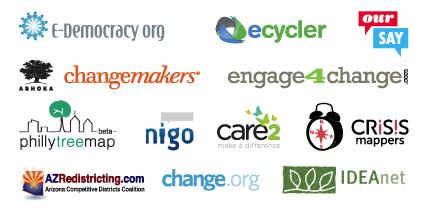Community Embraces New Word Game at Mid-Year Play Day This past Sunday, families at Takoma Park’s Seventh Annual Mid-Year Play Day had the opportunity to experience OtherWordly for the first time. Our educational language game drew curious children and parents to our table throughout the afternoon. Words in Space Several children gathered around our iPads […]
Read more Crowdsourcing means involving a lot of people in small pieces of a project. In educational and nonprofit outreach, crowdsourcing is a form of engagement, such as participating in an online course, collecting photos of butterflies for a citizen-science project, uploading old photos for a community history project, deciphering sentences from old scanned manuscripts, playing protein folding games to help scientists discover new ways to fight diseases, or participating in online discussions.
Crowdsourcing means involving a lot of people in small pieces of a project. In educational and nonprofit outreach, crowdsourcing is a form of engagement, such as participating in an online course, collecting photos of butterflies for a citizen-science project, uploading old photos for a community history project, deciphering sentences from old scanned manuscripts, playing protein folding games to help scientists discover new ways to fight diseases, or participating in online discussions.
Here’s an overview of several facets of crowdsourcing.
Motivations
Competition vs. collaboration are two common frameworks for projects. A competition can draw dozens or or thousands of participants who seek a prize. Unlike grant solicitations, these competitions are based on objective results, not on resumes, prior work or personal history. A collaboration typically involves a participant working on a small piece of a larger project.
The Walker Art Center ran a crowdsourced video festival & awards competition (First International Cat Video Festival) attracting 10,000 entries and over 10,000 attendees.

Fundraising
Crowd funding is when educational projects are funded by individual, online contributors or investors. Most crowdfunding is done via web sites which list projects, and provide a means for donors to commit. Typically, project funding is all-or-nothing.
One of the leading sites is Kickstarter, which since their launch in spring 2009, has funded over $417 million, funding over 36,000 creative projects. The “Let’s Build a Goddamn Tesla Museum” crowdfunding campaign on IndieGogo, another major crowdfunding site, enable a nonprofit group to buy Tesla’s old lab, which was threatened with development. The group raised over $1,370,511, reaching their original $800k goal in under a week.
Crowd funding tends to work best for a hip projects, on average, a third of projects are funded.
Crowdfunding is distinct from traditional, online fundraising, in that it is focused on projects, not general operations. In the traditional realm, in Q2 2012, charities reported $204-million in total online gifts (10.9% growth over Q2 2011) and $180.9-million for Q3 2012 (8.9% over Q3 2011), with an average gift of $77, according to data provided to The Chronicle of Philanthropy. More people are giving online, albeit in smaller amounts, than in past years.
See a prior blog post on crowdfunding virtual exhibits.
Workers
Cloud Labor is hiring a distributed virtual labor pool, available on-demand, to fulfull a range of tasks from simple to complex. With enticing projects, this can mean a ton of volunteers …
- The New York Public Library is developing a citizen cartography tool that lets the public take information archived on digitized historical maps and use the data to tag a searchable interface built with Open Street Map. The goal: a larger, more detailed database that will help future researchers.
- The National Library of Finland created the digitalkoot project to help digitize millions of pages of archival material. Visitors to the site transcribe old books one word at a time while playing a video game. Think CAPTCHA meets Angry Birds.
- The United States Holocaust Memorial Museum (in partnership with the private company Ancestry.com) has recruited “citizen historians” to research historical documents from WWII. The Children of the Lodz Ghetto project is designed to teach historical skills while “restor[ing] names and stories to those whose identities were nearly silenced by a force that nearly succeeded in making them disappear completely from history.”
- Many natural history museums coordinate “citizen science” projects that enlist public help to tackle large research challenges, like collecting and identifying ants, transcribing data from the labels on century-old cicadas or spotting celestial phenomena.
- Many other citizen science projects have elements of crowdsourcing. See SciStarter for more citizen science projects.
In addition, administrative work can sometimes be done. Fansourcing involves recruiting fans to do administrative tasks which are more interesting to enthusiastic fans (brand advocates) than low-level staff. It can connect volunteer fans with potential visitors via live chat, or moderating online discussions and answering customer service questions. The volunteers offer their genuine enthusiasm, not necessarily a deep professional expertise.
Aside from volunteer engagement, the majority of cloud labor is paid. Simple tasks are often paid at hourly rates below $5/hour. See a prior blog post on outsourcing some outreach tasks to freelancers. It tends to drive towards the lowest common denominator, so it’s best for tasks that are suitable for non-professionals. Quality control is often maintained by double and triple-checking work through redundancy. For example, if the task was to write tags describing a painting, the same painting could be tagged by 5 workers, with software to detect spammy responses, and look for tags common to multiple workers.
Politics
Civic Engagement is collective actions that address issues of public concern. This works on both local and national levels. The White House could collect ideas on how to change the manufacturing industry from those who work in it. It asks people which technologies they think are the most important to the industry, as well as what sort of future regulation they believe would be beneficial. Soliciting responses via the internet, in public, eliminates barriers to participation.

Knowledge of the crowd
Collective Knowledge is development of knowledge assets or information resources from a distributed pool of contributors. This type of mass collaboration is best showcased by the Wikipedia and other Wikimedia projects. Here are some smaller projects which collected votes from their community:
- The Smithsonian American Art Museum invited the public to vote via the Web on which examples of video games to include in its “Art of Video Games” exhibit.
- In 2010, the Walker had 50/50: Audience and Experts Curate the Paper Collection, in which visitors cast over a quarter million votes about which of 183 paper artworks should go into an upcoming exhibition.
- In 2008, the Brooklyn Museum invited visitors to help choose the best photos for an exhibition.

Talent of the crowd
Collective Creativity taps into creative talent pools to design and develop original art, media or content. This can mean new creative works by professionals, or non-professionals.
- Several museums, including the Smithsonian, The Children’s Museum of Indianapolis and the British Museum, have established positions for “Wikipedians in Residence.” The Wikipedians push museum data and images into the Wikipedia universe, as well as soliciting and managing content from the wiki-editing crowd. (See my blog post on reaching the public using Wikipedia.)
- RunCoCo is advice on how to run a community collection online (see PDF).
- New Zealand was looking to revitalize their tourism campaign, and hosted a contest for young filmmakers. Their reward was the opportunity to screen their work in front of famous filmmaker Peter Jackson, plus a trip to New Zealand to shoot and produce a 3-minute film.
- In 2007, World Without Oil, was a crowdsourced public media narrative which invited players to participate in a collaborative simulation of a global oil shortage by playing an online mystery game, and later generating their own stories about the crisis and strategizing ways to manage it.
Open Sourcing is a philosophy and approach that promotes free redistribution and access to an end product’s design and implementation details. It’s the opposite of keeping secrets or paid licensing. Key benefits are broader use and publicity. Some popular projects are also able to foster a community where people outside the organization also contribute. Typically, revenue comes from selling related services, or grants. For example, Omeka is a web-publishing platform for library, museum, archives, and scholarly collections and exhibitions.

Communities
Community Building is developing communities through active engagement of individuals who share common passions, beliefs or interests.
Preserapedia is an open encyclopedia for heritage conservation with over 1 thousand articles.

In business
The term was popularized by journalist Jeff Howe in a 2006 Wired article “The Rise of Crowdsourcing,” about outsourcing labor to the “crowd,” but the concept rapidly broadened beyond labor. In business, crowdsourcing now means obtaining services, ideas, content, or money from a large group of people. “Crowdsourcing has become a very successful business model for many startups such as YouTube, Wikipedia, Reddit, Threadless and Kickstarter – to name only a few. But so far, its usage by big companies has been sporadic and experimental,” notes François Pétavy, CEO of eYeka, a crowdsourcing platform. Pétavye says that use in the business world is growing, and that crowdsourcing now solves a variety of real world problems, have a demonstrable return on investment.
It is related to other evolving concepts. For example, Open Innovation is using of sources outside of the entity of group to generate, develop and implement ideas.

Tools are applications and platforms that support collaboration, communication, and sharing among distributed groups of people.
Source: The categories above, and the lede illustration, are adapted from Crowdsourcing.org. Several projects from AAM TrendsWatch 2012 (PDF).



